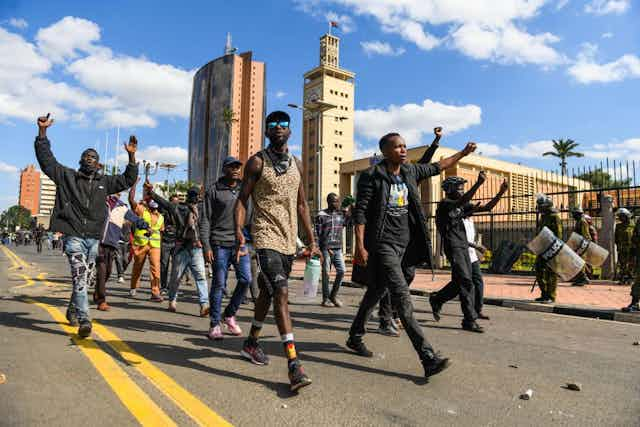
Kenya has a long history of protests. Mass protests took place during the colonial period and continued in the post-independence era.
Important democratic gains were achieved through protests, such as the introduction of multi-party politics in 1991. Many will also remember the violent clampdown that followed the disputed 2007 elections, which left more than 1,100 dead.
The dramatic scenes unfolding in Nairobi on 25 and 26 June 2024 are the latest episode in Kenya’s tumultuous protest history. Some protesters stormed the Kenyan parliament, where a contentious finance bill had been passed a few hours earlier, and set sections of it on fire.
By the day’s end, the government had called in the military to support the national police.
What seems different about the current wave of protests is that they are predominantly led by young people who are urban-based and multi-ethnic. The protests were also not confined to the capital, Nairobi. Street protests were witnessed in 35 of Kenya’s 47 counties.
In my research I focus on the political implications of urbanisation in Africa. In a recent paper, which examined the impact of urbanisation on political regimes in Africa, I show how protests and organised civil society play an important part in challenging regimes in urban areas.
The African continent is currently urbanising at the fastest pace in the world. Kenya is no exception. The intersection of urbanisation and a growing, young population is what makes the current dynamics particularly explosive.
The relation between cities and protests
Previous research shows that cities facilitate protests, for a number of reasons.
Firstly, cities are dense. This leads to lower organisational and transport costs and makes participation for individual protesters less risky. Studies have found that there is a correlation between city size and occurrence of protests.
Secondly, protests in capital cities are particularly effective due to their political significance and symbolic power, as the example of Nairobi shows. Protesters could physically storm parliament, where the decision makers are. This led to an immediate reaction from the government, when a day later President William Ruto withdrew the finance bill.
Thirdly, those who arrive in cities are often disappointed with the lack of government services. Many young Kenyans move to cities in search of economic opportunities and better services. But cities are largely not prepared for their rapid growth. It is estimated that more than half of all Kenyan city dwellers live in informal settlements. This creates grievances.
While the urban dimension of the current protests is not surprising, the multi-ethnic nature of Kenya’s recent protests is. My paper shows that cities don’t always bring different groups of people together as one might expect. Studies from Ghana, South Africa and Kenya suggest that newcomers often settle in areas alongside people of their own ethnic group and ethnic based networks continue to play important roles in city residents’ lives.
Rapid urbanisation and political change
The recent protests and the president’s decision show that a young, enlightened, urban population can drive a hard bargain with a state that is failing them.
To be effective, protests require broad-based mobilisation. Initially, the Kenyan protests were dismissed as middle-upper class due to large scale social media mobilisation. But the street protests spoke a different language.
In their book on uprisings in Africa, Adam Branch and Zachariah Mampilly point to the importance of the urban poor in protests. Their movements often don’t conform to classic forms of protest. They can be leaderless and violent. Both of these characteristics apply to the current protests in Kenya.
While previous protests in Kenya were often representing specific groups such as health workers and intern teachers, or were elite-led, the current protests are reported to have started on social media, organised primarily by Generation Z citizens – individuals born between the late 1990s and early 2010s.
This suggests that Kenya’s leaders will have to get used to the demands of young urbanites who seek different ways of political participation.
Even though urbanisation facilitates contentious politics, this does not mean in turn that urbanisation automatically leads to democratisation. My working paper finds that urbanisation structures the way citizens relate to the state. While urban density makes it easier to demand accountability at a collective level, urbanisation also increases pressure on public goods and services.
Inequality in cities is particularly high and the middle and upper classes might rather turn to the private sector or use clientelist ties to receive services instead of challenging the incumbent regime. Hence, the force to reckon with is rather the poor masses. It is not enough for governments to cater to the elites anymore, as the share of the urban poor becomes too large to ignore.